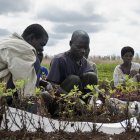BANGKOK, 27 February 2012 (IRIN)
 Photo: Courtesy of Frankie Abreu
Photo: Courtesy of Frankie Abreu
Construction underway for Dawei port
A development spree in Myanmar following recent political reforms may have hidden costs for rural dwellers, especially ethnic minorities, say analysts.
Speaking at a recent conference in Yangon on inclusive growth, former World Bank president and Nobel laureate Joseph Stiglitz warned that Myanmar risked becoming "a rich country with poor people", as quoted in local media.
In 2011, foreign investment in mining, oil, gas and hydropower in Myanmar totalled US$20 billion, according to the government.
And while a $3.6 billion project to construct a dam on the Irrawaddy River for a hydropower plant was suspended due to protests stemming from environmental and social concerns, including the projected displacement of thousands of villagers from the northern state of Kachin, a deepwater port project is going ahead, despite similar criticisms.
Saw Frankie Abreu, a coordinator with the local NGO Another Development for Burma, believes the multi-billion dollar project in the southeastern city of Dawei in Tanintharyi Region may displace tens of thousands of villagers and boost undocumented migration to Thailand.
The Burmese government has defended the proposed port, whose construction began late 2011, as a boon to the local economy, but community activists say the gains are coming at too high a cost.
While the government is creating four new villages to house the displaced, Saw Frankie Abreu criticized the plan as insufficient.
"We have seen the houses they are building. They are building one house for each family, but it is for... just four or five people. But villagers have more children than that. And also most of the time they are extended families, but the government is counting this as one family. So where will the others go?" Saw Frankie Abreu asked.
The displacement will "severely" affect the livelihoods of the ethnic minorities living in these villages who are unable to adapt to the new locations, said Khin Ohmar, coordinator of the Burma Partnership, a network of NGOs based in northern Thailand.
"The Mon and Karen people are the majority in this area. They depend on the orchards and farming, like growing betel nuts, for their livelihood. Their livelihoods depend entirely on the land they live on," Khin Ohmar told IRIN.
One of the villages under construction for the displaced from Dawei is 60km north in Bawa village.
"Bawa is a fishing community," said Saw Frankie Abreu, "while the Dawei people are farmers. The land in Bawa is not suitable for farming, so people are now thinking of moving, or are already moving to other places."
A number are trying neighbouring Thailand, said Khin Ohmar.
Win Kay Thi, a Burmese migrant worker from Dawei living in the southern Phang Nga Province of Thailand, told IRIN she would bring her mother and sister, who live in Dawei, to join her.
"I have settled in Thailand as a migrant worker for more than five years, so I understand the environment here. In [Myanmar], I don't know the place where my family is going and my family also doesn't know about the new situation [in Bawa], so I will bring them here," Win Kay Thi said.
"Others in the village are also talking about moving to Thailand," she added. "People in the area are very worried about their future. Right now buildings are mushrooming. They are accelerating the building."
The International Organization for Migration recently estimated 1.4 million unregistered Burmese workers and family members already in Thailand.
"When locals first heard about the project, grassroots people were very optimistic," Saw Frankie Abreu said. "They thought they would get job opportunities, maybe transportation would be better, maybe they can start taking local goods to markets in the city better. Then they started realizing the challenges."
http://www.irinnews.org/report.aspx?reportID=94955
 Photo: Courtesy of Frankie Abreu
Photo: Courtesy of Frankie Abreu Construction underway for Dawei port
A development spree in Myanmar following recent political reforms may have hidden costs for rural dwellers, especially ethnic minorities, say analysts.
Speaking at a recent conference in Yangon on inclusive growth, former World Bank president and Nobel laureate Joseph Stiglitz warned that Myanmar risked becoming "a rich country with poor people", as quoted in local media.
In 2011, foreign investment in mining, oil, gas and hydropower in Myanmar totalled US$20 billion, according to the government.
And while a $3.6 billion project to construct a dam on the Irrawaddy River for a hydropower plant was suspended due to protests stemming from environmental and social concerns, including the projected displacement of thousands of villagers from the northern state of Kachin, a deepwater port project is going ahead, despite similar criticisms.
Saw Frankie Abreu, a coordinator with the local NGO Another Development for Burma, believes the multi-billion dollar project in the southeastern city of Dawei in Tanintharyi Region may displace tens of thousands of villagers and boost undocumented migration to Thailand.
The Burmese government has defended the proposed port, whose construction began late 2011, as a boon to the local economy, but community activists say the gains are coming at too high a cost.
While the government is creating four new villages to house the displaced, Saw Frankie Abreu criticized the plan as insufficient.
"We have seen the houses they are building. They are building one house for each family, but it is for... just four or five people. But villagers have more children than that. And also most of the time they are extended families, but the government is counting this as one family. So where will the others go?" Saw Frankie Abreu asked.
The displacement will "severely" affect the livelihoods of the ethnic minorities living in these villages who are unable to adapt to the new locations, said Khin Ohmar, coordinator of the Burma Partnership, a network of NGOs based in northern Thailand.
"The Mon and Karen people are the majority in this area. They depend on the orchards and farming, like growing betel nuts, for their livelihood. Their livelihoods depend entirely on the land they live on," Khin Ohmar told IRIN.
One of the villages under construction for the displaced from Dawei is 60km north in Bawa village.
"Bawa is a fishing community," said Saw Frankie Abreu, "while the Dawei people are farmers. The land in Bawa is not suitable for farming, so people are now thinking of moving, or are already moving to other places."
A number are trying neighbouring Thailand, said Khin Ohmar.
Win Kay Thi, a Burmese migrant worker from Dawei living in the southern Phang Nga Province of Thailand, told IRIN she would bring her mother and sister, who live in Dawei, to join her.
"I have settled in Thailand as a migrant worker for more than five years, so I understand the environment here. In [Myanmar], I don't know the place where my family is going and my family also doesn't know about the new situation [in Bawa], so I will bring them here," Win Kay Thi said.
"Others in the village are also talking about moving to Thailand," she added. "People in the area are very worried about their future. Right now buildings are mushrooming. They are accelerating the building."
The International Organization for Migration recently estimated 1.4 million unregistered Burmese workers and family members already in Thailand.
"When locals first heard about the project, grassroots people were very optimistic," Saw Frankie Abreu said. "They thought they would get job opportunities, maybe transportation would be better, maybe they can start taking local goods to markets in the city better. Then they started realizing the challenges."
http://www.irinnews.org/report.aspx?reportID=94955











 Flickr/Karl Faktor
Flickr/Karl Faktor



 Flickr/SwathiSridharan
Flickr/SwathiSridharan 










